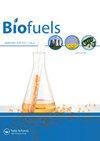木质纤维素生物质的理化特性、热分析和热解动力学
IF 2.6
4区 工程技术
Q3 ENERGY & FUELS
引用次数: 1
摘要
本文章由计算机程序翻译,如有差异,请以英文原文为准。
Physicochemical characterization, thermal analysis and pyrolysis kinetics of lignocellulosic biomasses
Abstract This paper compares and evaluates the physicochemical characterization and thermal analysis of different agricultural lignocellulosic biomasses namely: olive pomace (OP), argan shells (AS), date palm seeds (DS) and hydrochar (HC), obtained from the hydrothermal carbonization (HTC) of OP, in order to identify a good potential fuel for thermochemical conversion systems. Several physicochemical and thermal characterization methods were used. The aforementioned biomasses are mainly composed of cellulose, hemicellulose and lignin as shown by the FTIR and XRD analysis. From energy point of view, the hydrochar (HC) has the highest value of the higher heating value (HHV) (27.86 MJ/kg). These results make (HC) a very good candidate for thermochemical energy conversion technologies. Thereafter, thermal analysis (DSC and TGA) was conducted in an inert atmosphere to analyze the thermal behavior of the samples under well-defined thermal conditions. Right after, two kinetics models were used to estimate pyrolysis kinetic parameters (the activation energy (E) and pre-exponential factor (A)) of the four biomasses. Among those are, for example, olive pomace has (E = 200.104 kJ/mol; A = 7.14E + 21 s−1) and (E = 199.053 kJ/mol; A = 3.58E + 21 s−1) according to KAS and FWO models, respectively. Consequently, pyrolysis of (OP) requires less energy to occur, which promotes its energy performances. GRAPHICAL ABSTRACT
求助全文
通过发布文献求助,成功后即可免费获取论文全文。
去求助
来源期刊

Biofuels-Uk
Energy-Renewable Energy, Sustainability and the Environment
CiteScore
5.40
自引率
9.50%
发文量
56
期刊介绍:
Current energy systems need a vast transformation to meet the key demands of the 21st century: reduced environmental impact, economic viability and efficiency. An essential part of this energy revolution is bioenergy.
The movement towards widespread implementation of first generation biofuels is still in its infancy, requiring continued evaluation and improvement to be fully realised. Problems with current bioenergy strategies, for example competition over land use for food crops, do not yet have satisfactory solutions. The second generation of biofuels, based around cellulosic ethanol, are now in development and are opening up new possibilities for future energy generation. Recent advances in genetics have pioneered research into designer fuels and sources such as algae have been revealed as untapped bioenergy resources.
As global energy requirements change and grow, it is crucial that all aspects of the bioenergy production process are streamlined and improved, from the design of more efficient biorefineries to research into biohydrogen as an energy carrier. Current energy infrastructures need to be adapted and changed to fulfil the promises of biomass for power generation.
Biofuels provides a forum for all stakeholders in the bioenergy sector, featuring review articles, original research, commentaries, news, research and development spotlights, interviews with key opinion leaders and much more, with a view to establishing an international community of bioenergy communication.
As biofuel research continues at an unprecedented rate, the development of new feedstocks and improvements in bioenergy production processes provide the key to the transformation of biomass into a global energy resource. With the twin threats of climate change and depleted fossil fuel reserves looming, it is vitally important that research communities are mobilized to fully realize the potential of bioenergy.
 求助内容:
求助内容: 应助结果提醒方式:
应助结果提醒方式:


